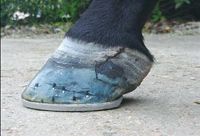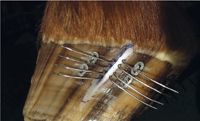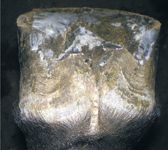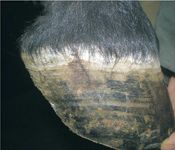Hoof cracks: Finding cause is key to treatment, repair
The term "quarter crack" was heard much more frequently this year after Kentucky Derby and Preakness winner Big Brown was treated for the hoof condition prior to the Belmont Stakes, but equine veterinarians, podiatrists and farriers know that quarter cracks affect all types of racing and performance horses and sometimes work horses.
The term "quarter crack" was heard much more frequently this year after Kentucky Derby and Preakness winner Big Brown was treated for the hoof condition prior to the Belmont Stakes, but equine veterinarians, podiatrists and farriers know that quarter cracks affect all types of racing and performance horses and sometimes work horses.

Photo 1: An example of a quarter crack.
Some question the terminology, preferring "hoof crack" instead, but agree that the condition can impede a horse's ability because of pain and instability of the hoof wall.
It's "a common cause of foot lameness or decreased athletic performance in race and sport horses," says equine podiatry specialist Stephen O'Grady, DVM, BVSc, MRCVS, at Equine Podiatry, Northern Virginia Equine.

Photo 2: Stainless steel wires (21 gauge) are used to "stitch" the crack. The ends are pulled tight and bent outward.
"It affects every lineage, breed, sex, every walk of (horse) life," says William Moyer, DVM, who heads the Large Animal Clinical Sciences Department at Texas A&M University's College of Veterinary Medicine.
"They (quarter cracks) are more likely to occur, or seem to have a higher incidence, in horses that race for a living, and probably the incidence in Standardbred racehorses is, in my experience, higher than in Thoroughbreds," Moyer says. "But you occasionally see it even in a horse that isn't doing anything for a living, and you wonder how he ever got it."

Photo 3a: A sheared heel.
In performance horses, some type of hard blow to the foot is the most frequent cause of quarter cracks, according to Tom Curl, a farrier with Global Lameness Consultants, Vero Beach, Fla. "Show jumpers and hunters, and some reiners and cutters, get a trauma crack, either from smacking themselves or coming down hard off a jump and landing just on one side of the foot, or they just whack the other foot and split it."

Photo 3b: The quarter crack present in Photo 3a, on the displaced side.
Typically, quarter cracks originate at the top of the hoof, at the coronary band, and proceed distally toward the floor of the hoof. "A true quarter crack," says O'Grady, "is full-thickness, a fracture that extends into the dermis of the hoof, often leading to instability, inflammation and infection.
"If you take your thumb and put it against either side of the crack and push on it, it will move, and usually the horse will show signs of pain," O'Grady explains.
Causes, he says, "may include trauma to the coronary band, pre-existing damage to the corium from infection, abnormal hoof conformation, focal foot imbalances, short shoes or an abnormal landing pattern when the foot strikes the ground."
Quarter cracks become more painful with infection and/or the result of instability caused by movement of the hoof wall posterior to the crack. Vertical movement of the heel bulb on the affected side further complicates the instability.
"Rather than call it quarter crack, you're best to call it hoof crack, because a quarter crack is very specific. The quarter is a portion of the foot, but you can have toe cracks, heel cracks, etc.," Moyer says.
"Basically there are two ways to end up with a hoof crack, though there are really more than two," he says.
"One is to have an injury to the tissue that is responsible for creating the horn. For instance, I've got an old wound on my left thumb and therefore a permanent defect in the thumbnail because the germinal tissue that produces horn is absent," Moyer explains. "You'll see horses with the same thing."
Previous injury may produce a defect, which in turn produces a permanent crack, sometimes because of an infection around the coronary tissue, or the horse stepping on it. "Any situation that can cause trauma to your fingernail or toenail could happen to a horse," Moyer says.
The second most common situation, Moyer explains, is that hoof cracks repre-
sent a failure of the hoof wall, where sheer forces are such that the hoof just splits. "For the most part, these are horses with reasonably weak feet, that tend to have a low heel, longish kind of toe, flat foot and a thin hoof. That describes an awful lot of Thoroughbreds," says Moyer. "In most cases, it's a mechanically induced injury."
Cause is critical to treatment
"Basically the repair process is two-fold," notes Moyer. "One is to try to figure out, if you can, how did it get there? The second objective is to stabilize the crack, because the thing that hurts is motion at the crack site, initiating inflammation and pinching below it."
O'Grady agrees that determining cause is crucial to the proper treatment. "There are as many ways to repair a quarter crack as there are quarter cracks, but ... (learning the) cause is most important," he says.
Quarter cracks originate from three areas: limb conformation, foot conformation and landing pattern.
» LIMB CONFORMATION: It may start from the shoulder or knee down, when the limb is rotated outward in such a way that the horse lands on one side of the foot and then puts pressure on the inside.
» FOOT CONFORMATION: A horse's foot may be offset to one side, so it bears more load on that side; or it may have a low or under-run heel, where sufficient structure in the back of the foot is lacking. "This type of heel may be weak due to insufficient hoof-wall growth and there may be insufficient solar surface to adequately support the palmar/plantar part of the foot," O'Grady says.
In addition there may be increased pressure in the quarter and heel during the stance phase, as a result of delayed breakover caused by the long toe. Upright hoof conformation with high heels promotes heel-first landing, which increases pressure through the heels and quarters.
» LANDING PATTERN: A horse with a quarter crack generally is one that lands or impacts the ground asymmetrically, impacting first on one side of the hoof and then loading the opposite side. This strike pattern often is related to conformation, but also can be caused by improper trimming.
Asymmetric landing may place extra forces on one side of the hoof wall, producing enough force to proximally displace the heel bulb. Along with abnormal conformation, this landing pattern can lead to a shearing force or increased pressure within the lamina.
The landing pattern and the conformation of the foot also may perpetuate quarter cracks caused by trauma to the coronary band or a previous abscess.
Repair procedures
For repair, horses usually are divided into two categories — those that have to perform immediately, and those that can have a short layoff.
"If we have a short layoff, we will usually trim the foot appropriately and put a bar shoe on them, solid all the way around," O'Grady explains. The bar stops the vertical movement of the two heels, so you stabilize the back part of the foot. If done appropriately, the foot will begin to heal immediately. In a month's a time, you'll have a quarter to three-eighths of new growth above the quarter crack.
"If the horse has to work right away, to perform in a rodeo or run in the Kentucky Derby, then we will go ahead and repair the crack. Repair involves using an implant, to 'stitch' it, putting some hairpin wires across the crack opening from either side, and repairing it. Once that's in place, the finishing is patching over the defect with an adhesive bond."
Most Thoroughbreds have a thin hoof wall, with little sole, thus fragile feet, says O'Grady. "If there's a quarter crack, it is usually behind the widest part of the foot, behind the area where you're going to nail. If you use a nail-on shoe, you could actually lower that side a little bit more, leave a little space under there, i.e., float it, allowing the heel to be 'out in space.'
"In a Thoroughbred that is going to run in light aluminum shoes, a shoe with a polyurethane insert might be best for cushioning. We glue them on.
"If you have a jumper or hunter, a horse with a heavy foot, barrel-racing horse, I would rather have a steel shoe on that horse," O'Grady says, "because it has more ground surface and stability, and if I'm going to use a steel shoe I'd much rather nail it on."
Ultimately, the experts agree, it's critical to deal with each horse as an individual that requires individual attention, likely differing in each case, each conformation, each purpose for which the horse is used.
Big Brown's hoof crack
About 10 days prior to the Belmont Stakes, during treatment for some inflammation, the quarter crack in Big Brown's hoof was observed. The horse had two previous quarter-crack incidents in 2007, and the last patch made the previous winter was still good; there had been substantial growth.
On Monday before the Belmont race, hoof specialist Ian McKinlay stitched the crack closed, and says that by Friday the tissue was perfect. The old suture was removed and replaced, and the crack was covered with methyl-acrylic adhesive.
The team added a glue-on Yasha shoe, a simple shoe with a dual-duro- meter rim pad adhered to an existing shoe. The pads absorb shock and keep the hard shoe off the sole.
By Belmont Stakes day, the procedure had gone well, with no sign of infection.
Big Brown didn't win the last leg of the Triple Crown but, according to McKinlay, the hoof crack was not responsible.
Kane is a Seattle author, researcher and consultant in animal nutrition, physiology and veterinary medicine, with a background in horses, pets and livestock.